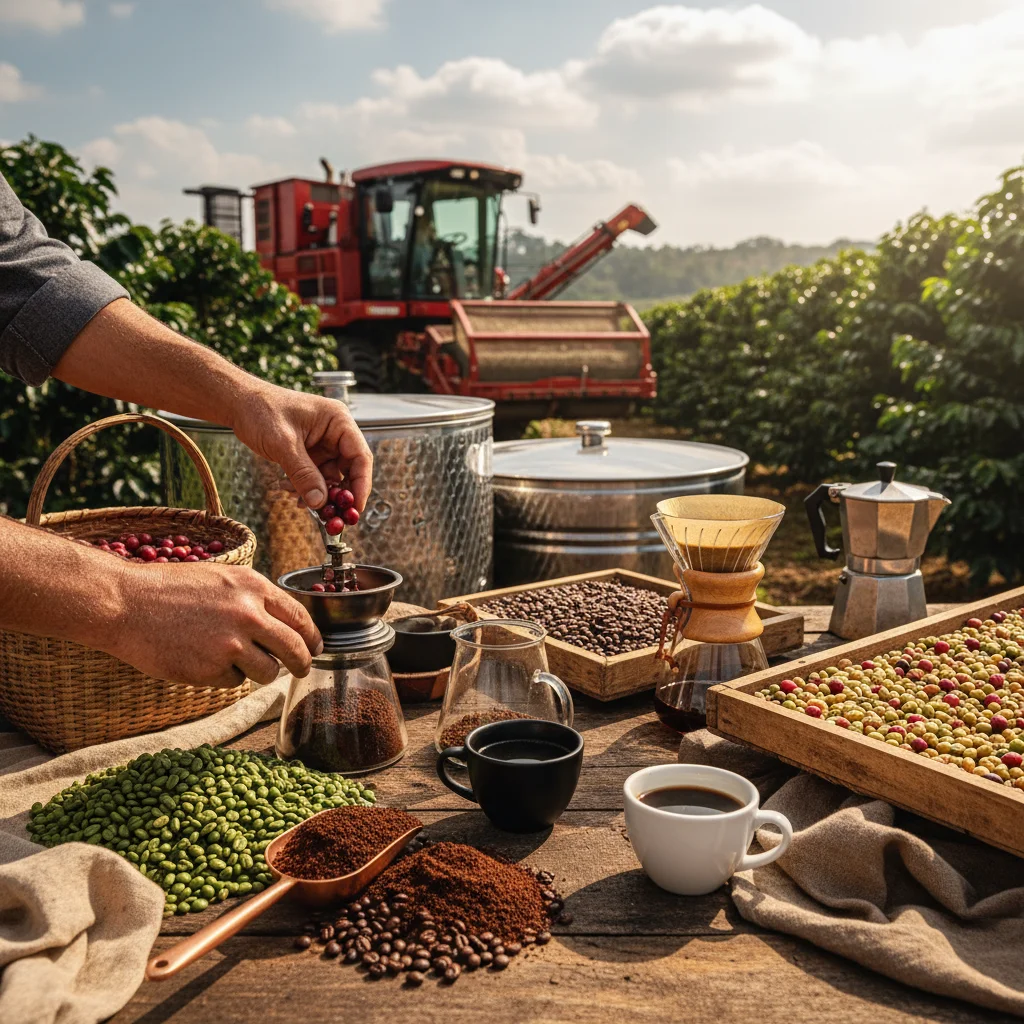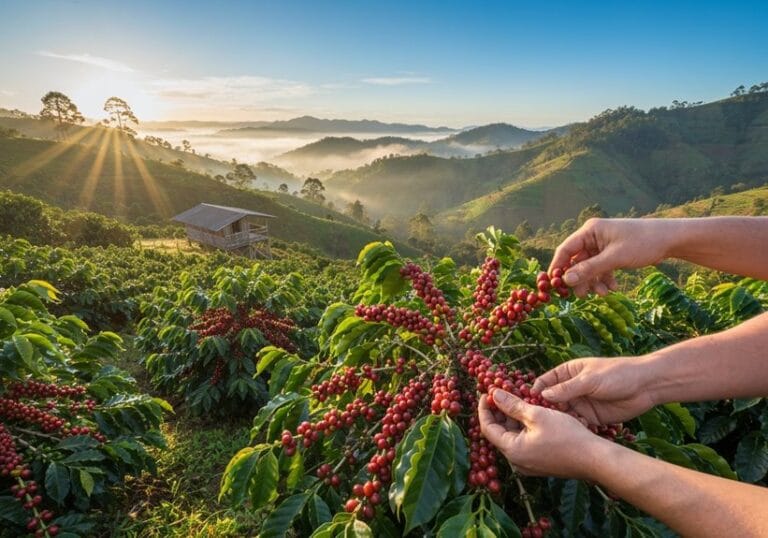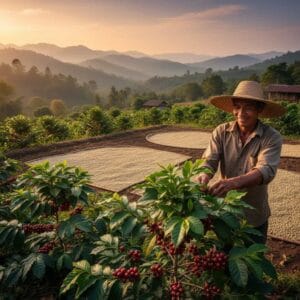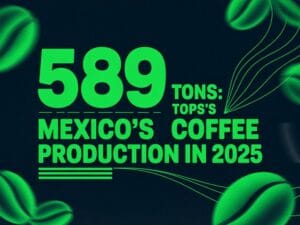Colombia’s coffee game is seriously impressive! Did you know they snag the tertiary spot globally, cranking out up to a million tons of coffee? That’s like a mountain of beans, friends! But here’s the kicker—climate’s throwing a tantrum, making things bumpy for farmers (yikes!). Plus, 92% of that liquid gold gets exported, leaving Colombians to sip on just a tiny bit at home. Oh, and younger folks are all about those fancy brews now! Stick around, there’s more to spill!
Key Takeaways
- Colombia is the third-largest coffee producer globally, contributing about 7% of the world’s coffee output.
- Annual production ranges between 885,000 to 1 million metric tons, equivalent to 12.9 to 11.1 million 60-kg bags.
- Around 92-93% of Colombian coffee is exported, predominantly as high-quality washed arabica.
- The U.S. is the primary market, with Canada and Europe also significantly importing Colombian coffee.
- Despite rising prices, domestic consumption is increasing, expected to reach 2.3 million bags in 2024/25.
Colombia’s Global Coffee Ranking
When you think of coffee, it’s like instantly smelling that fresh brew wafting through the air, right?
Well, guess what? Colombia is a major player in the coffee game! In fact, Colombia ranks third in global coffee production, trailing only Brazil and Vietnam.
They produce around 885,000 to 1 million metric tons—yep, that’s a whopping 12.9 to 11.1 million 60-kg bags! Can you believe that? It’s about 7% of the world’s total coffee output! Colombia is known for high-quality coffee as it combines high and low altitude farming practices that enhance the flavor profiles. Interestingly, Yemen’s exclusive production monopoly on coffee was broken when the Dutch secured viable beans, illustrating the global significance of coffee cultivation. Coffee leaf rust and other diseases pose risks to production, making sustainability essential for maintaining this output.
So, next time you savor that rich, aromatic cup, remember, a good chunk of it likely comes from Colombia.
And yes, a lot of coffee is imported from Colombia. Just a little reminder: quality trumps quantity every single time!
Impact of Climate on Production Volatility
While one might assume that Colombia’s coffee production flows smoothly like a freshly brewed cup, the reality is that climate changes toss a wrench in those plans, stirring up quite the drama! Rising temperatures and shifting rainfall patterns wreak havoc on Colombian coffee, impacting yields. Seriously, does all coffee come from Colombia? With smallholder farmers bearing the brunt of these shifts, their livelihoods hang by a thread (yikes!).
Here’s a peek at the chaos:
| Climate Factor | Impact |
|---|---|
| Temperature Rise | Inconsistent yields, higher pests |
| Changing Precipitation | Flood risks and soil problems |
| Pest and Disease Pressure | Increased coffee leaf rust chances |
In short, the coffee industry is steering through a wild ride!
High Export Rates and Market Distribution

Colombian coffee isn’t just something to sip while scrolling through social media—it’s a major player on the global stage! Seriously, in 2024, exports shot up by 16% to over 12 million bags! That’s like coffee swimming in a caffeinated ocean!
The U.S. is Colombia’s top market, but don’t count out Canada or Europe—they’re in the coffee mix too. Fun fact: about 92-93% of that delicious brew is shipped overseas! So, if it seems like your hipster cafe has a Colombian twist, you’re right!
As washed arabica takes the spotlight—think of it as the coffee version of a Hollywood star—the exports keep rocketing. And with record-high prices, it just gets better! Who knew coffee could be so exciting?
Domestic Consumption Trends Despite Rising Prices
Often, people might assume that with sky-high coffee prices, Colombians would be ditching their beloved brews, but hold onto your mugs!
Colombians are still sipping on their java, even as prices take a little hike. Check this out:
- Domestic consumption is expected to reach around 2.3 million 60-kg bags for 2024/25!
- Younger coffee lovers are shifting towards specialty brews – goodbye, boring coffee!
- COVID-19 got everyone brewing at home like a barista—talk about caffeine creativity!
- Despite rising prices, local lovers still prefer Colombia’s quality over cheaper imports.
Historical Milestones in Coffee Production

Coffee has been more than just a drink for Colombians; it’s got a whole story, and it’s not all about sipping lattes in cozy cafés!
Imagine this: coffee beans introduced by Jesuits in 1730, growing in Santander—who knew priests could be so caffeinated? Fast forward to 1808, they exported just 100 bags.
Then in the mid-19th century, they were like, “Let’s go BIG!” with production skyrocketing! But wait—the Great Depression hit, shaking things up and turning big estates into slice-of-life “small farm” dramas.
Enter 1927: farmers unite, creating the Federación Nacional de Cafeteros to tackle fair trade—like a coffee Avengers team! Thanks to them, today’s Colombian coffee reigns supreme.
Who knew history could be so deliciously complicated?
Frequently Asked Questions
What Varieties of Coffee Are Primarily Grown in Colombia?
Colombia primarily grows Arabica coffee varieties, with significant cultivation of Castillo, Caturra, Typica, Bourbon, Tabi, and Colombia varieties. These coffees are prized for their flavor, adaptability, and resistance to diseases, particularly Coffee Leaf Rust.
How Does Colombian Coffee Differ From Coffee Produced in Other Countries?
Colombian coffee primarily consists of washed Arabica beans, known for their bright acidity and fruity aroma, distinguishing them from other countries that produce natural or pulped natural coffees, which often exhibit heavier, chocolaty flavor profiles.
What Challenges Do Colombian Coffee Farmers Face Besides Climate Issues?
Colombian coffee farmers face escalating production costs, labor shortages, market volatility, pest pressures, and shifting agricultural practices. These challenges hinder their ability to sustain and grow output, impacting their long-term viability and financial stability.
How Are Colombian Coffee Prices Determined on the Global Market?
Colombian coffee prices are determined by global supply and demand, exchange rates, and futures market trends. Environmental factors and quality assessments also greatly influence pricing, impacting the competitiveness of Colombian coffee on the international stage.
What Initiatives Promote Sustainable Coffee Farming Practices in Colombia?
Initiatives promoting sustainable coffee farming in Colombia include eco-friendly technology adoption, organic practices, biodiversity conservation, regenerative agriculture, and community-led efforts that prioritize soil health and farmer education, enhancing both environmental sustainability and economic resilience.
References
- https://dailycoffeenews.com/2025/05/29/colombia-coffee-report-production-decline-predicted-amid-weather-and-regulatory-volatility/
- https://cropgpt.ai/colombia-coffee-market-january-2025
- https://apps.fas.usda.gov/newgainapi/api/Report/DownloadReportByFileName?fileName=Coffee+Annual_Bogota_Colombia_CO2025-0014.pdf
- https://dataverseeinc.in/coffee-exporters-by-country/
- https://en.wikipedia.org/wiki/List_of_countries_by_coffee_production





